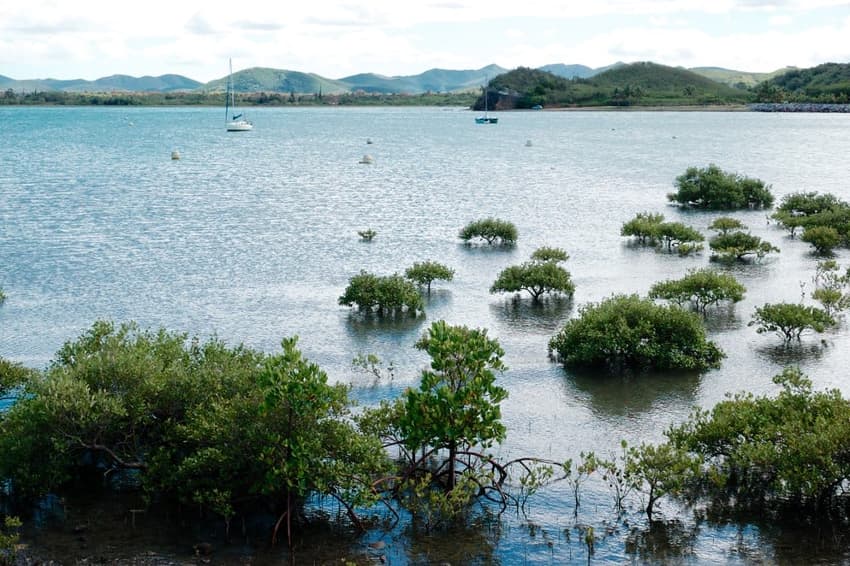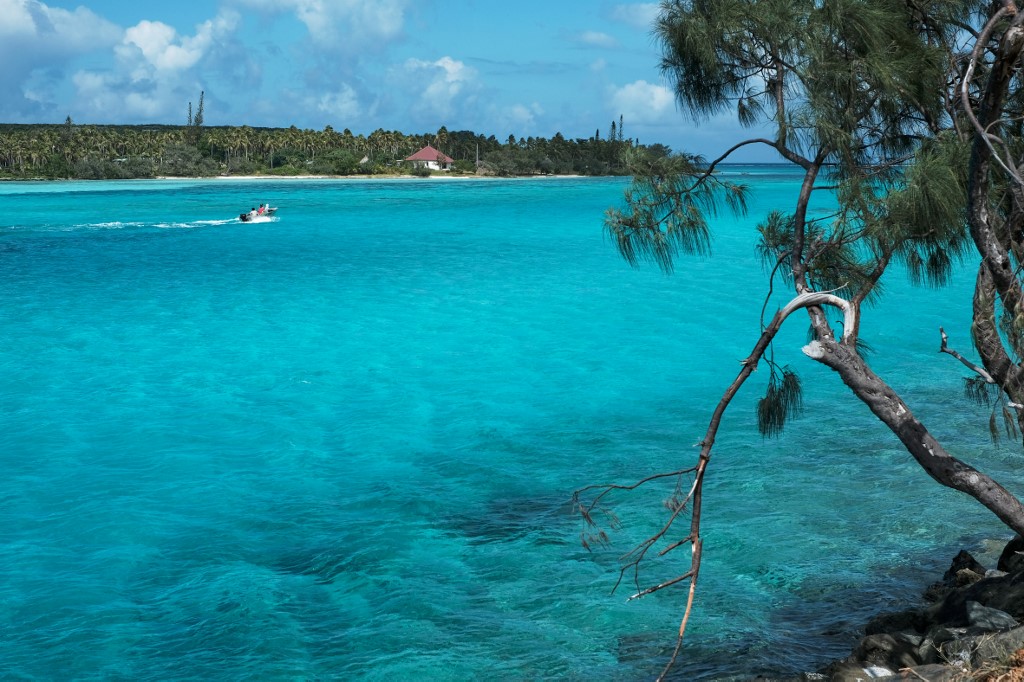Five things to know about the far-flung French territory of New Caledonia

Voters in the tiny Pacific island of New Caledonia are set to vote again on independence from France. Here's what is happening and how the island became French in the first place.
The French South Pacific territory of New Caledonia has been granted a third referendum on independence, with voters to decide on whether to break away from France's control after almost 170 years.
1. It's French but not part of France
France has five overseas départements - French Guiana in South America, Martinique and Gaudeloupe in the Caribbean and Réunion and Mayotte in the Indian Ocean. They are as much a part of France as Dodorgne or Paris and fall under the direct control of the French government. So when people tell you that France shares a border with Brazil, this is actually true because French Guiana borders Brazil.
As well as these départements d'Outre mer (overseas départements) France also has collectivité d'Outre mer (overseas collectives) which have more autonomy and can pass their own laws about domestic issues, but which fall under the control of Paris for issues like defence.
New Caledonia (Nouvelle-Calédonie) is a collectivité but has special status, negotiated in 1988, which gives it gradually increasing autonomy.
All these possessions outside 'the Hexagon' - as mainland France is known to distinguish it from the overseas départements - are the legacy of empire and French colonialism.
READ ALSO Confetti of an empire - a look at France's overseas territories

2. It looks like Scotland (apparently)
Home to some 269,000 people, New Caledonia is about 18,000km from mainland France - and 2,000km east of Australia.
It was seized by the French admiral Auguste Febvrier-Despointes in 1853, who declared that he wanted to assure his country of a "position in the Pacific."
But New Caledonia's name hails from the sailor who was the first European to spot it, British explorer Captain James Cook, who said that the island - with its UNESCO World Heritage Site coral reefs and lagoons - reminded him of Scotland.
It was initially used as a penal colony for convicts and political prisoners, and was declared an overseas territory of France in 1946.
3. It is ethnically mixed
The bulk of New Caledonia's population is made up of indigenous Melanesians known locally as Kanaks (39 percent) and European inhabitants, known as Caldoches (27 percent).
There are also minorities from the relatively nearby Polynesia Pacific region, including Wallis and Futuna islanders, and smaller numbers of Tahitians, Indonesian and Vietnamese.
The indigenous population fell sharply in the late 19th century as European settlers brought with them new diseases such as smallpox and measles.
A growing part of the population now identifies as mixed-race or "Caledonian."
4. There is a long history of independence struggles
There has been a long history of ethnic tensions in New Caledonia, starting in 1878 when a Kanak insurgency over the rights of Kanaks in the mining industry left 200 Europeans and 600 rebels dead. Some 1,500 Kanaks were sent into exile.
Clashes between Kanaks and Caldoches in the 1980s culminated in a bloody attack and hostage-taking by Kanak separatists in 1988, when six police officers and 19 militants were killed on the island of Ouvea.
A landmark deal between France and opponents and supporters of independence followed in 1988, giving the islands more autonomy and allowing referendums over independence.
In the referendum in 2018, 57 percent voted to remain part of France; in the second, in October 2020, that decreased to 53 percent. There will be a third vote held before October 2022.
5. It has a lot of nickel
New Caledonia boasts a quarter of the world's known reserves of nickel, a core component in the manufacture of stainless steel, rechargeable batteries and coins.
Nickel is, along with aid from the French state, the island's largest source of income, making up 7 percent of GDP in 2018, though in some years the figure can reach 20 percent depending on market prices.
Comments
See Also
The French South Pacific territory of New Caledonia has been granted a third referendum on independence, with voters to decide on whether to break away from France's control after almost 170 years.
1. It's French but not part of France
France has five overseas départements - French Guiana in South America, Martinique and Gaudeloupe in the Caribbean and Réunion and Mayotte in the Indian Ocean. They are as much a part of France as Dodorgne or Paris and fall under the direct control of the French government. So when people tell you that France shares a border with Brazil, this is actually true because French Guiana borders Brazil.
As well as these départements d'Outre mer (overseas départements) France also has collectivité d'Outre mer (overseas collectives) which have more autonomy and can pass their own laws about domestic issues, but which fall under the control of Paris for issues like defence.
New Caledonia (Nouvelle-Calédonie) is a collectivité but has special status, negotiated in 1988, which gives it gradually increasing autonomy.
All these possessions outside 'the Hexagon' - as mainland France is known to distinguish it from the overseas départements - are the legacy of empire and French colonialism.
READ ALSO Confetti of an empire - a look at France's overseas territories

2. It looks like Scotland (apparently)
Home to some 269,000 people, New Caledonia is about 18,000km from mainland France - and 2,000km east of Australia.
It was seized by the French admiral Auguste Febvrier-Despointes in 1853, who declared that he wanted to assure his country of a "position in the Pacific."
But New Caledonia's name hails from the sailor who was the first European to spot it, British explorer Captain James Cook, who said that the island - with its UNESCO World Heritage Site coral reefs and lagoons - reminded him of Scotland.
It was initially used as a penal colony for convicts and political prisoners, and was declared an overseas territory of France in 1946.
3. It is ethnically mixed
The bulk of New Caledonia's population is made up of indigenous Melanesians known locally as Kanaks (39 percent) and European inhabitants, known as Caldoches (27 percent).
There are also minorities from the relatively nearby Polynesia Pacific region, including Wallis and Futuna islanders, and smaller numbers of Tahitians, Indonesian and Vietnamese.
The indigenous population fell sharply in the late 19th century as European settlers brought with them new diseases such as smallpox and measles.
A growing part of the population now identifies as mixed-race or "Caledonian."
4. There is a long history of independence struggles
There has been a long history of ethnic tensions in New Caledonia, starting in 1878 when a Kanak insurgency over the rights of Kanaks in the mining industry left 200 Europeans and 600 rebels dead. Some 1,500 Kanaks were sent into exile.
Clashes between Kanaks and Caldoches in the 1980s culminated in a bloody attack and hostage-taking by Kanak separatists in 1988, when six police officers and 19 militants were killed on the island of Ouvea.
A landmark deal between France and opponents and supporters of independence followed in 1988, giving the islands more autonomy and allowing referendums over independence.
In the referendum in 2018, 57 percent voted to remain part of France; in the second, in October 2020, that decreased to 53 percent. There will be a third vote held before October 2022.
5. It has a lot of nickel
New Caledonia boasts a quarter of the world's known reserves of nickel, a core component in the manufacture of stainless steel, rechargeable batteries and coins.
Nickel is, along with aid from the French state, the island's largest source of income, making up 7 percent of GDP in 2018, though in some years the figure can reach 20 percent depending on market prices.
Join the conversation in our comments section below. Share your own views and experience and if you have a question or suggestion for our journalists then email us at [email protected].
Please keep comments civil, constructive and on topic – and make sure to read our terms of use before getting involved.
Please log in here to leave a comment.